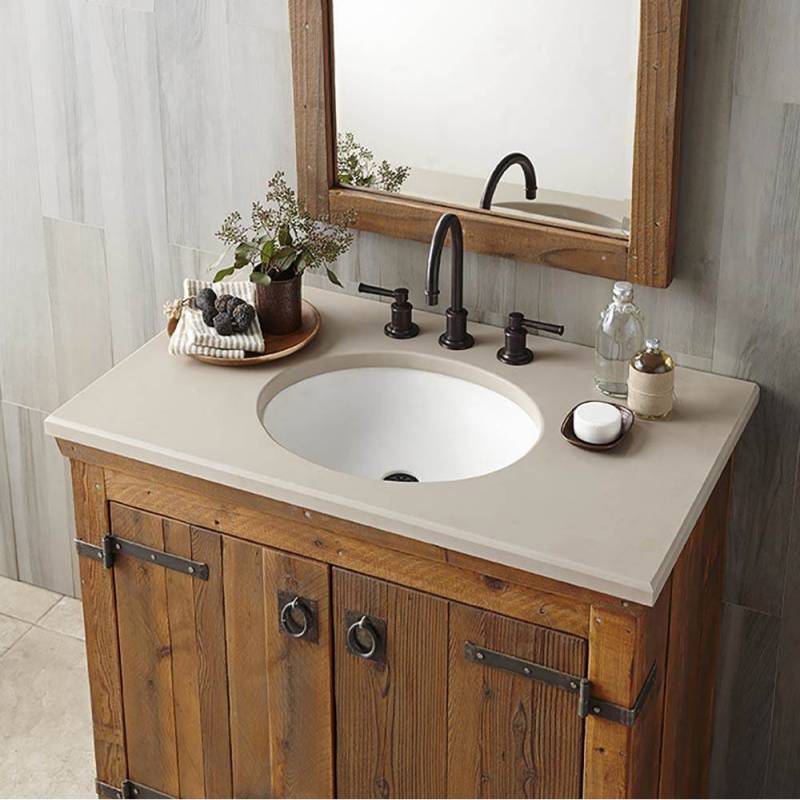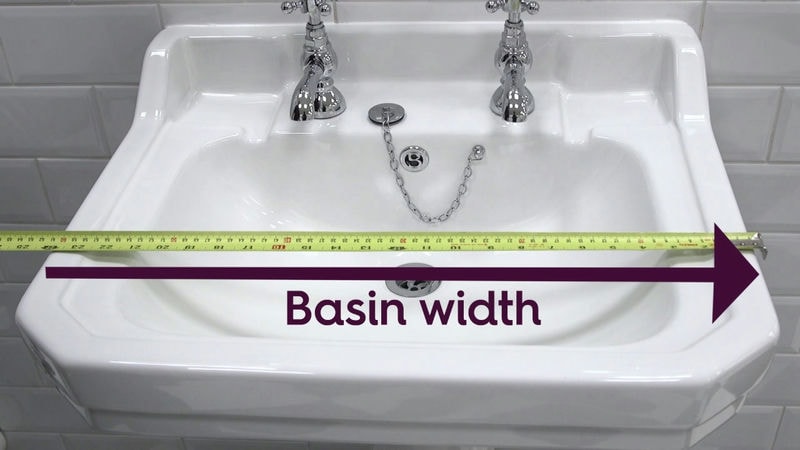 English
English
Jabra Sanitary is a sanitaryware supplier offering toilets, sinks, faucets, bathtubs, etc., at competitive prices. If you're a distributor, wholesaler, or project contractor, get a quote today!
 $23.9 Limited-time Offer
$23.9 Limited-time Offer Consignment Policy
Consignment Policy 20 Years of Experience
20 Years of Experience
Choosing the right bathroom sink size is crucial for both functionality and aesthetics. The dimensions, height, and depth of a bathroom sink directly impact the overall usability and look of your bathroom.
Whether you're remodeling or setting up a new bathroom, understanding bathroom sink dimensions is key to ensuring the perfect fit. In this guide, we'll walk you through standard bathroom sink sizes, types of sinks, and how to accurately measure your vanity sink.

Table of Contents
Standard Bathroom Sink Sizes
Types of Bathroom Sinks and Typical Sizes
How to Measure a Bathroom Sink
How to Choose the Right Bathroom Sink Size
Shop Bathroom Sinks and Basins
FAQs
Conclusion
When choosing a bathroom sink, it's important to understand the standard bathroom sink dimensions including bathroom sink width and bathroom sink depth available to ensure the best fit for your space.
Standard bathroom sink sizes, which means average bathroom sink dimensions, typically range from 16 to 24 inches in width and 5 to 8 inches in depth, but they can vary depending on the style and design.

Below, we will cover common large, medium, and smaller sink dimensions, as well as unique shapes like round, oval, and triangular sinks.
Common Large Sink Sizes
Large bathroom sinks are ideal for spacious bathrooms and are often used in master suites. These sinks typically range from 20 to 30 inches in width, with a depth of 8 to 12 inches.
The larger size provides ample space for washing and is perfect for households with multiple users.
Medium-Sized Sink Dimensions
Medium-sized sinks are the most common in residential bathrooms, offering a balance between space and functionality. These sinks usually measure between 16 to 20 inches in width, with a depth of 5 to 8 inches. They fit well in standard-sized vanities and are versatile enough for various bathroom styles.
Smaller Sink Dimensions
For smaller bathrooms or powder rooms, compact sinks are a popular choice. These sinks typically measure between 12 to 16 inches in width, with a depth of 4 to 6 inches. Despite their smaller size, they can still offer functionality while saving valuable space.
Round, Oval, and Triangular Sink Sizes
Round and oval sinks are often chosen for their smooth, aesthetic appeal. Round sinks usually range from 16 to 20 inches in diameter, while oval sinks are slightly larger, ranging from 18 to 22 inches in width.
Triangular sinks, ideal for corner installations, typically measure around 15 to 20 inches on each side. These unique shapes can add a distinctive look to your bathroom while fitting specific design needs.
Pedestal Sink
Pedestal sinks are a classic choice for bathrooms with limited space. The typical width of a pedestal sink ranges from 18 to 24 inches, with a depth of around 6 to 8 inches. These sinks stand alone, supported by a pedestal, making them an excellent option for small bathrooms where storage isn't a priority.
Drop-in Sink
Drop-in sinks, also known as self-rimming sinks, are designed to be installed into a cut-out on the vanity top. The common dimensions for these sinks range from 16 to 24 inches in width, with a depth of 5 to 8 inches. They are versatile and easy to install, fitting well in most standard vanities.
Undermount Sink
Undermount sinks are installed beneath the countertop, creating a seamless look. These sinks typically measure between 16 to 24 inches in width, with a depth of 5 to 9 inches. Undermount sinks are a popular choice for modern bathrooms, offering a sleek and easy-to-clean design.
Vessel Sink
Vessel sinks sit on top of the countertop, resembling a bowl or basin. The typical dimensions for vessel sinks range from 16 to 20 inches in diameter, with a height of 5 to 8 inches. These sinks are a statement piece, adding an elegant touch to contemporary bathroom designs.
Wall-Mounted Sink
Wall-mounted sinks are installed directly onto the wall, freeing up floor space. These sinks usually range from 14 to 20 inches in width, with a depth of 5 to 8 inches. They are ideal for small bathrooms or those designed with accessibility in mind, as they offer easy access from a wheelchair.
Double Sink Vanity
A double sink vanity is perfect for shared bathrooms, offering two sinks side by side. The typical width for each sink in a double vanity ranges from 18 to 24 inches, with a depth of 5 to 8 inches.
This setup requires a wider vanity top, often measuring between 60 to 72 inches in total width which is the whole double bowl sink dimensions.
ADA-Compliant Bathroom Sink
ADA-compliant sinks are designed to meet the standards of the Americans with Disabilities Act, ensuring accessibility for all users. These bathrooom sinks typically have a height of 34 inches or less, with a shallow bowl depth of around 6.5 inches to allow for wheelchair access. The width can vary, but most ADA sinks are around 18 to 22 inches.
How to Measure a Bathroom Sink
Accurately measuring your bathroom sink is essential to ensure it fits your vanity and meets your needs. Here's a step-by-step guide to help you with bathroom sink measurement correctly.

Step 1: Measure the Sink Width
Start by measuring the width of your sink from one outer edge to the other. For rectangular or square sinks, measure from left to right. For round or oval sinks, measure the diameter at the widest point. This measurement will help you determine if the sink will fit within your vanity.

Step 2: Measure the Sink Depth
Next, measure the depth of the sink from the top edge to the bottom of the basin. This is especially important for undermount and vessel sinks, as it affects both the functionality and the installation. Ensure the depth allows enough room for water flow without causing splashing.
Step 3: Measure the Sink Height
For vessel sinks, it's important to measure the bathroom sink depth, as these sinks sit above the countertop. How to measure a drop in sink? Just measure from the base of the sink to the top edge.
For other types of sinks, bathroom sink height is typically not a major factor, but it's still good to know for accurate installation.
Step 4: Measure the Faucet and Drain Location
Finally, measure the distance between the faucet holes, the drain, and the edge of the sink. This will ensure that your faucet aligns correctly with the sink and that the drain fits properly. This step is crucial for drop-in and undermount sinks where precise alignment is needed.
How to Choose the Right Bathroom Sink Size
Selecting the right bathroom sink size involves more than just measuring the space. Here are key factors to consider:
Consider Your Bathroom Size
The size of your bathroom plays a significant role in determining the appropriate sink size. Larger bathrooms can accommodate wider and deeper sinks, while smaller bathrooms benefit from compact or corner sinks to maximize space.
Match the Sink Size with Your Vanity
Your vanity should complement the size of your sink. A sink that is too large or too small for the vanity will look unbalanced and could affect the overall functionality. Ensure the sink fits within the vanity with enough room for any additional countertop space you may need.
Think About User Needs
Consider who will be using the sink and how often. For families, a double sink vanity might be more practical. If the sink is for a guest bathroom, a smaller, stylish option might suffice.
Additionally, consider the height of users, particularly in households with children or individuals with mobility issues.
Style and Design Preferences
Your bathroom sink should match the overall style of your bathroom. For modern designs, vessel or undermount sinks might be more suitable. Traditional or classic bathrooms may benefit from pedestal or drop-in sinks. The shape of the sink—whether round, oval, or rectangular—also plays a role in the aesthetic.
Evaluate Plumbing and Installation Needs
Before choosing a sink, assess your current plumbing setup. Some sinks, like wall-mounted or pedestal sinks, may require changes to the existing plumbing. Make sure the sink you choose is compatible with your current setup or be prepared for additional installation work.
Shop Bathroom Sinks and Basins
When it comes to purchasing a bathroom sink, Jabra sink brand has a variety of options available from different styles and materials to sizes and colors. Double-check the sink's dimensions and read reviews to ensure it meets your needs.
For those looking for something unique, custom sinks from bathroom sink brands are an option. You can work with a designer or craftsman to create a sink that perfectly matches your bathroom's decor and dimensions. While more expensive, a custom sink can add a personalized touch to your bathroom.
FAQs
Does the Shape of the Sink Matter?
Yes, the shape of the sink can affect your bathroom's aesthetics and functionality. Round sinks offer a softer look and are often easier to clean, while rectangular sinks provide more basin space. The shape should also complement your vanity and bathroom design.
What Bathroom Sink Parts and Accessories Do You Need?
When installing a new bathroom sink, you'll need a faucet, drain assembly, and sometimes a pop-up drain stopper. Depending on the type of sink, you might also need mounting hardware or a countertop sealant. It's important to choose accessories that match the style and finish of your sink for a cohesive look.
How to Fit a New Sink in a Bathroom?
Fitting a new sink involves measuring the space, selecting a sink that matches the dimensions, and ensuring the plumbing setup is compatible. Once you have the correct measurements and sink type, you can install the sink following the sink manufacturer's instructions.
For drop-in sinks, this typically involves cutting a hole in the countertop, while wall-mounted sinks require securing the sink to the wall.
How Do I Clean a Bathroom Sink?
Cleaning a bathroom sink is simple with the right materials. Use a mild soap or specialized cleaner and a soft cloth to wipe down the sink regularly. For tougher stains, a mixture of baking soda and water can help. Avoid using abrasive cleaners or tools that can scratch the surface of the sink.
How Many People Are Using the Sink?
If multiple people will be using the sink, consider a double sink vanity to accommodate everyone. For single-user bathrooms, a standard or smaller sink will suffice. The number of users impacts not only the size of the sink but also the overall bathroom layout.
Conclusion
Choosing the right bathroom sink size is essential for both practicality and design. By understanding the different bathroom sink dimensions, types, and how to measure your sink, you can ensure that your vanity/bathroom is both functional and stylish.





















